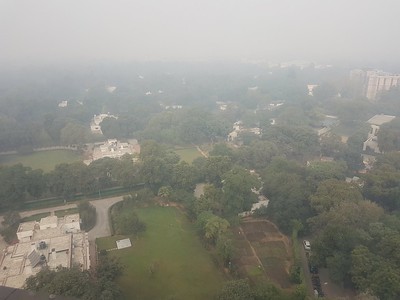As we look at Diwali in the rear-view mirror and wonder if Delhi and other parts of North India can see anything at all, the question, which was last raised during the Farm Law negotiations, has returned. As stubble in Punjab and Haryana have been lit on fire again, and the Government, while rolling back the farm laws, has also promised to decriminalize stubble burning, let us tackle the ploughing bull by its horns; are the farmers who burn stubble to be solely blamed for the winter smog in Delhi?
Stubble burning by farmers in Punjab and Haryana does lead to an increase in pollution in Delhi, but the simple truth is a bit more complicated. Many have argued that stubble burning has been in practice, admittedly at a smaller scale, since the 1980s, but the great Delhi smog is a relatively recent phenomenon – the burning is not to blame at all. That is unfortunately not true. The burning does deserve its share of the blame. Thanks to NASA’s Earth Observatory, much like with other causes of pollution, we can track the smoke from the stubble burning on its journey to Delhi NCR.
But to understand the why and how of the problem, we must revisit certain historical events.
The History
Historically, Punjab had always grown what is considered to be their traditional crops, i.e maize, pearl millet, pulses and oilseeds. During the early 1980s, driven by the Green Revolution the Central Government incentivized Punjab farmers to shift to paddy and wheat cultivation. The Central Government had argued for this change in the name of “food security”. However, this was done with little thought about sustainability and indegenious practice.
Fast-forward to 2000 – guaranteed MSP incentivised cultivation of rice and wheat and electricity and water subsidies made it possible for Punjab to slowly become one of the biggest producers of rice.
And all was well, till the unseen cost of this continuous cycle of rice and wheat finally caught up. Rice is a very water-intensive crop. With an electricity subsidy to run machines to extract groundwater coupled with the availability of free water, Punjab produced a lot of rice at the cost of diminishing their groundwater.
Eventually, this caught the state government’s eye and it was in 2005 that the Punjab State Farmers Commission (PSFC) came up with a seemingly novel idea. Rice cultivation till then was generally done in April and hence depended heavily on the groundwater. The PSFC suggested that the government ban sowing rice in April and ask the farmers to sow rice only during the monsoon season to reduce groundwater distress. This seemed sound on paper and in 2009 the Punjab Government passed the Punjab Preservation of Subsoil Water Act. This was soon followed by the Haryana Preservation of Subsoil Water Act, 2009 by the Haryana Government which was facing the same problem.
That moment in 2009 was a turning point. Punjab and Haryana were producing more rice, thanks to the Green Revolution than either of the states or for that matter the country required. Instead of going back to the traditional sustainable crops of maize, millet, pulses, etc, the respective governments decided to intervene and entrench rice cultivation deeper in the states.
The Fallout
The decision to change the planting cycle, taken without the involvement of farmers and their expertise, caused two different kinds of issues. For the farmers, the delayed cycle meant that if the monsoon failed, they would be left with no other crop. Additionally, the seasonal change also increased the need for pesticides and other additional costs. On the other hand, it also meant that farmers had less time to properly harvest and clear their fields before the next cropping season for wheat began. This is more pertinent to the discussion at hand, because at this stage of the farming season, in order to quickly clear their fields for the next harvest, farmers were left with only one quick and cheap option to get rid of the stubble that is generated post harvest– burn it.
All this leads us to the last factor the beauracary never accounted for, i.e the location of Delhi. For in the land-locked city, winter is when the wind almost dies down. By the time the stubble smoke from Punjab and Haryana reaches Delhi in late October-November, the wind speed has slowed down to a crawl in the region. And this pushes the usually “yellow”, in terms of Delhi’s air quality, to “red”.
To sum up the story, one could blame farmers in Punjab and Haryana for burning stubble in winter. And they do share some of the blame as the smoke from the stubble, along with Diwali crackers, is perhaps what pushes the usually very bad Delhi air to outright toxic. But if one looks at the line-up of the usual suspects, one will notice that government intervention devoid of stakeholder involvement is perhaps the real guilty party which gets to walk away scot-free. Now that stubble burning is decriminalized as a result of the Farm Laws negotiations and all political parties are falling over themselves to offer Punjab free electricity ahead of the state’s upcoming polls, matters may only get worse. The situation is likely to turn dire not just for Delhi NCR, but also for Punjab’s groundwater levels.
It’s true that Delhi air would be toxic even without the stubble burning. However, maybe without the government trying to change cropping patterns in 2009 and throw horrible incentives since the 1980s (in the race to win elections), it could have been much easier to breathe in Delhi winters.
Read more: Community Forest Rights: Lessons for India
Post Disclaimer
The opinions expressed in this essay are those of the authors. They do not purport to reflect the opinions or views of CCS.






